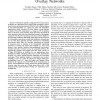Free Online Productivity Tools
i2Speak
i2Symbol
i2OCR
iTex2Img
iWeb2Print
iWeb2Shot
i2Type
iPdf2Split
iPdf2Merge
i2Bopomofo
i2Arabic
i2Style
i2Image
i2PDF
iLatex2Rtf
Sci2ools
FCCM
2006
IEEE
2006
IEEE
Packet Switched vs. Time Multiplexed FPGA Overlay Networks
— Dedicated, spatially configured FPGA interconnect is efficient for applications that require high throughput connections between processing elements (PEs) but with a limited degree of PE interconnectivity (e.g. wiring up gates and datapaths). Applications which virtualize PEs may require a large number of distinct PE-to-PE connections (e.g. using one PE to simulate 100s of operators, each requiring input data from thousands of other operators), but with each connection having low throughput compared with the PE’s operating cycle time. In these highly interconnected conditions, dedicating spatial interconnect resources for all possible connections is costly and inefficient. Alternatively, we can time share physical network resources by virtualizing interconnect links, either by statically scheduling the sharing of resources prior to runtime or by dynamically negotiating resources at runtime. We explore the tradeoffs (e.g. area, route latency, route quality) between time-multipl...
| Added | 11 Jun 2010 |
| Updated | 11 Jun 2010 |
| Type | Conference |
| Year | 2006 |
| Where | FCCM |
| Authors | Nachiket Kapre, Nikil Mehta, Michael DeLorimier, Raphael Rubin, Henry Barnor, Michael J. Wilson, Michael G. Wrighton, André DeHon |
Comments (0)

